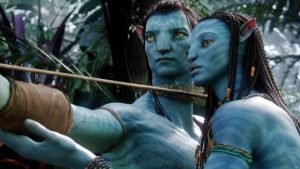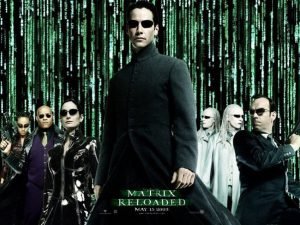How has Hinduism inspired Hollywood movies?


Indians occupy a special place in God’s Consideration and grace. They were the first among creation who put all their might to comprehend and reach Divinity. In the deep dense Jungle among the most testing environment, free from worldly attraction they performed contemplation unceasingly. Through Yoga they have shut the five senses and meditated on the source of all. They followed the their breath and reached the inner world. Vedaham Etam Purusam mahantam Aditya varnam tamasah parastat.
Before the birth of Govind, Brahma ji performed a Stuti in 2 Shlokas. This is known as Garbha Stuti of Govind.
These 2 Shlokas are pretty much enough to know who Krishna is. Otherwise even Lord Shiv finds himself unable to describe wo actually Krishna is!
Satya-vratam Satya-param Tri-satyam
Satyasya yonim-nihitam-ch-satye
Satyasya-satyam rita-satya-netram
Satyatmakam tvam saranam prapannah
(Srimad Bhagwatam 10.2.26)
The philosophy behind a couple of super hit movies in Hollywood is based on Hinduism. Hollywood itself has actually been embracing arcane Indian systems for a long time now. A few well-known Hollywood stars have willingly and openly expressed this fact to the public.
Obvious and hidden references to Hindu symbolism can be found in many movies, including Batman, Superman and Memento. Let’s examine the plots of some movies that are based on Vedic teachings.
Avatar (2009)

Well it’s not surprising that James Cameron’s Avatar has hit the all time success as it portrays the picture of a cosmic nature.
First of all the word ‘Avatar‘ is Sanskrit, an ancient Indian language, in which much of India’s literature was written. It is closely translated in English as ‘incarnation’. The term, is most widely associated in Hinduism with Lord Vishnu, the deity whose Avatar (incarnations) are often depicted as having blue skin, similar to the Na’vi in Cameron’s Avatar.
Just as Hindu gods, particularly Vishnu, become avatars to save the order of the universe, the film’s avatar must descend to avert impending ultimate doom, effected by a rapacious greed that leads to destroying the world of nature and other civilizations.
रामाय रामभद्राय रामचन्द्राय वेधसे ।रघुनाथाय नाथाय सीतायाः पतये नमः ॥27॥
“You used your maya to generate the handsome serpent Ananta who lies down in the water and two extremely strong creatures. I was also born from a divine lotus, as resplendent as the sun, originating in your navel. You said that creation was my task and invested everything in me. O lord of the universe! Having taken up the burden invested on me, I worshipped you. Because you are more energetic than me, I asked you to protect creatures. Since that time, for the sake of protecting all creatures, you gave given up your eternal and invincible form and assumed the form of Vishnu.”
O’ Śrī Rāma, It was You alone who annihilated all the worlds by Your Māyā (Sankalpa) before the new creation and then after, You slept on the causal ocean (as Nārāyaṇa). Around that time, in the beginning of creation I (Brahmā) was born from You.”
“O the destroyer of the adversaries. You are seen (to exist) at the beginning and at the end of creation.”
“You are the mystic syllable ‘OM’. You are higher than the highest. People neither know your end nor your origin nor who you are in reality.”
Tails of the Na’vi’s very closely resembles the Monkey people or Vanaras met by Lord Rama in the deep woods of Central India, and who became his allies under the leadership of their king Sugriva and their champion Hanuman.
Another concept found in Hindu diaspora is leaving one’s body temporarily and entering the body of another person. Something quite similar happens in the movies as Humans are able to temporarily enter the body of a Na’vi. In Hinduism, this concept is called as Parakaya Pravesham. Puranas have hundreds of stories based on astral travel or body travel.
A more visible symbol in the movie is that of the characters in Avatar riding on a flying dragon like being. This is more like Lord Vishnu riding on a giant bird Garuda. Many Indian deities are shown flying on a bird/animal cum vehicle.
The colour Blue is used to depict “the infinite nature of Brahman” (Supreme Spirit, because blue is the colour of the sky, ether and divinity) that is manifested through Avatars. Hence the reason, pictures of Avatars such as Rama and Krishna are blue.
Explaining the choice of the color blue for the Na’vi, Cameron said “I just like blue. It’s a good color … plus, there’s a connection to the Hindu deities, which I like conceptually.” Cameron also said “I have just loved … the mythology, the entire Hindu pantheon, seems so rich and vivid. I didn’t want to reference the Hindu religion so closely, but the subconscious association was interesting, and I hope I haven’t offended anyone in doing so.”
Matrix Trilogy (1999 – 2003)

Peter Rader, a Hollywood movie producer claims that the Matrix movie is actually based on yogic principles. It says that this world is an illusion. It’s about Maya – that if we can cut through the illusions and connect with something larger we can do all sorts of things. The hero of the movie gains the capabilities of advanced Yogis who are believed to be able to defy laws of normal reality.
Matrix is of that age when machine will reproduce the human being and have total controls of everything. There is a virtual reality program that make them feel alive but in reality they were in a cave where they have a connection of that virtual reality program directly behind of their head. When they go inside the virtual reality program they feel it real because the virtual reality program hide fact that whatever they are doing is not real and they are totally in the control of machine.
In Hindu Ithihasas, there is also a Virtual Program called ‘Maya‘ made by god to hide himself to all people. So people live in the effect of Maya and think everything is real but in reality everything is virtual.
In movie, there was a group of people who came out of that virtual reality program and know the real world. They know what is real and what is virtual. But still they dont have hundred percent believe when they are in that program.
So in Hinduism, there are many saints who have seen beyond Maya and met with god. They know whatever looks is false reality is beyond this wall of imagination.
The concept of “Guru” or spiritual teacher is wonderfully depicted through the interaction of Morpheus and Neo. The action choreography of the movies especially of that between Neo and Mr. Smith at the end, matches the descriptions of fighting between Duryodhana and Bhima in the Mahabharata.
Navras, The track that plays over the closing credits is a Vedic Shloka. The song contains an adaption of the Asato ma mantra found in the Hindu sacred text the Brihadaranyaka Upanishad.
asato mā sad gamaya, tamaso mā jyotir gamaya, mṛtyor mā amṛtaṁ gamaya, Om shānti shānti śhāntiḥ
From ignorance lead me to truth
From darkness lead me to light
From death lead me to immortality
Om peace, peace, peace
Interstellar (2014)

In the movie Interstellar, the entire plot design was based on the ideal of a universal super-consciousness that transcends space and time and in which all human life is connected. This belief has actually existed for nearly 3000 years and the concept itself originates from the Vedic period.
In Interstellar, there is a concept- 1 Hour on Miller planet is equal to 7 Years on Earth. Due to a technical snag, the team is forced to spend 3 hours on that planet resulting in the loss of 23 years on Earth. Which means 10 years old daughter of Hero becomes 33 years old and the hero remains of the same age.
In Hindu scriptures, once in the war between Deva and Asura (Gods & Demons), Lord Indra took the help of (Human) king Muchukunda. King Muchukunda helped gods in the war, but the war lasted for 1 year and that was in heaven. After the war was over, when Muchukunda expresses desire to go back to earth to meet his family, Indra tells him that 1 year in Heaven is equal to 360 years on Earth, hence his family & kingdom must have been destroyed by now with the passage of time.
Shrimad Bhagawata Gita (9-3-27 to 36) gives a story that king Kakudmi and his daughter Revati travels through heaven to meet the deity Brahma. Lord Brahma explained them that time runs differently on different planes of existence, and that during the short time they had waited in heaven to see him, thousands of years had passed on Earth. When King Kakudmi and Revati returned to earth, they were shocked by the changes that had taken place. Landscape and environment on earth were changed and mankind was at a lower level of development than in their own time. The Bhagavata Purana describes that they found the race of men had become “dwindled in stature, reduced in vigour, and enfeebled in intellect.”
Another scene in the movie has the hero of the film, played by Matthew McConaughey, referencing a central notion of the oldest philosophical manuscripts of India, known as the Upanishads. These ancient writings embrace that the individual minds of humans are simply concise manifestations within a celestial one.
McConaughey’s character also engages in a situation that references Indra’s net. Indra’s Net is a Hindu metaphor that portrays the entire universe as an everlasting “web of existence spun by the king of the gods, each of its intersections adorned with an infinitely sided jewel, every one continually reflecting the others.”
Star Wars Series

In Star Wars, Princess Leia is kidnapped and held against her will by an evil Warlord, Darth Vader. Her desperate cry for help is delivered by a mysterious non-human entity—the android R2-D2—to the youthful hero Luke Skywalker. The hero then comes to the princess’s rescue, aided by a devoted and noble creature that is half-man and half-animal, Chewbacca.
By the end of the original “Star Wars” trilogy, Luke, aided by the mystical Jedi knight Obi-Wan Kenobi and leading legions of anthropomorphic bear soldiers, wages a huge war. Darth Vader and his evil empire are defeated, the princess is returned to safety, and peace and righteousness return.
By comparison, in the Ramayana, Princess Sita is also kidnapped and held against her will by the demon Ravana. Her cry for help is delivered by a mysterious non-human entity—Jatayu—to the youthful hero Lord Rama. Rama then comes to his wife’s rescue, aided by a devoted and noble creature that is half-man and half-animal, the monkey god Hanuman.
तथा रूपम् हि वैदेहीम् न दास्यन्ति यदि प्रियाम् ||नाशयामि जगत् सर्वम् त्रैलोक्यम् स चर अचरम् |यावत् दर्शनम् अस्या वै तापयामि च सायकैः ||
“If my ladylove is not returned indeed in a fine fettle as she was before my running after Golden Deer, I will be annihilating the triad of world in its entirety, together with its mobile and sessile beings, and I will be sweltering the entire universe with my arrows as long as I am not going to get a glimpse of her.”
Rama also wages a war to get Sita back, leading an army of Vanaras (bears and monkeys who have anthropomorphic characteristics), and finally rescues her from Ravana. The forces of the underworld defeated, Rama-raja (the kingdom of truth and righteousness) reigns supreme.
There are also other parallels between Star Wars and the Vedic tradition. The relationship between Yoda and Luke is similar to the traditional guru/disciple relationship, and the instructions Yoda gives are “almost verbatim” from the Bhagavad Gita, the ancient spiritual manual spoken by Lord Krishna to Prince Arjuna before the war of Mahabharata.
As the training progresses, Luke learns to control what is called ‘The Force’. Yoda explains that everything is part of the Force, such as the “…the tree, the rock…” etc. This Force is very similar to the Hindu concept of the One or the Universe (in essence Om). In Hinduism it is said that we are all part of the One, just like what Yoda said about the Force. Simply put, it is concluded that Yoda was referring to “the Force” as the Force of the One.
George Lucas, the creator of Star Wars, didn’t exactly deny all these similarities, but was very guarded about his influences, saying enigmatically, “I’m telling an old myth in a new way.”
Inception

Inception is essentially Indian philosophy re-visited. According to Adi Shankaracharya, (788-820 AD), the renowned exponent of the Advaita Vedanta School of philosophy, there is a dichotomy between illusion and reality which he succinctly sums up in the following quote: “Brahma satya. Jagat mithya, jivo brahmaiva naparah” (Brahman is the only truth, the spatio-temporal world is an illusion, and there is ultimately no difference between Brahman and individual self.)
The Hindus believe that our “reality” is an illusion, or ‘Maya’. More specifically, it is the dream of a God. The universe comes into being when the great preserver Lord Vishnu falls asleep. Brahma emerges from his navel, floating on a lotus flower, and begins the work of creation. After a number of aeons, Vishnu awakens, Brahma is sucked back into his navel, and the universe is destroyed.
According to the movie, as one goes deeper and deeper into the Dream Levels, time is stretched, what is 5 minutes in reality turn to an hour in Level 1 and so on, increasing exponentially and successively, as one goes deeper into the Levels. The deeper you go, the further removed your mind is from reality.
This concept of Dream level and Dream Time of inception is again similar to The Hindu units of measurement.
1 day (day only) of Brahma = 4.32 billion human years = 1000 Mahā-Yugas
The Ultimate Reality of Brahma
1 day of the Devas (Gods) = 1 year of Human
The Devas’s Level
1 day of the Pitṛs (ancestors) = 30 days of the Human
The Pitr’s (Ancestor’s) Level
1 Day of Human = Our (Normal Human’s) Level
Thus, life as we know it is but a dream, generated because our god-self has fallen asleep. We have forgotten our origins. We have come to believe that this dream is real. In this spiritual limbo, we will continue to be born into a life of suffering over and over.
According to Hinduism the whole world is nothing but a manifestation of god’s thoughts. As long as we possess desires, it is difficult to attain Nirvana, because the desire will pull us down. It is not impossible, but slowly and steadily we have to give up all desires. We can enjoy what comes to us as a Prasadam, as a gift from God, but to crave will make us a slave. Therefore, we must not have passions and obsessions . There is nothing wrong in enjoying what the Lord gives us, but to run behind material world pleasures, possessions and people is a sure way to slip under the mat of Nirvana, Moksha, salvation, liberation. Therefore, we have to live like a lotus in the pond but not sink in the pond. We should be like a boat that goes in the waters of this world, but doesn’t sink in it. We can live in this world, but we should not be a slave of our desires. Then only can we attain Nirvana or Moksha.
paritrāṇāya sādhūnāṁ
vināśāya ca duṣkṛtām
dharma-saṁsthāpanārthāya
sambhavāmi yuge yuge
To deliver the pious and to annihilate the miscreants, as well as to reestablish the Dharma, I Myself appear, millennium after millennium.
DISCLAIMER: The author is solely responsible for the views expressed in this article. The author carries the responsibility for citing and/or licensing of images utilized within the text.
